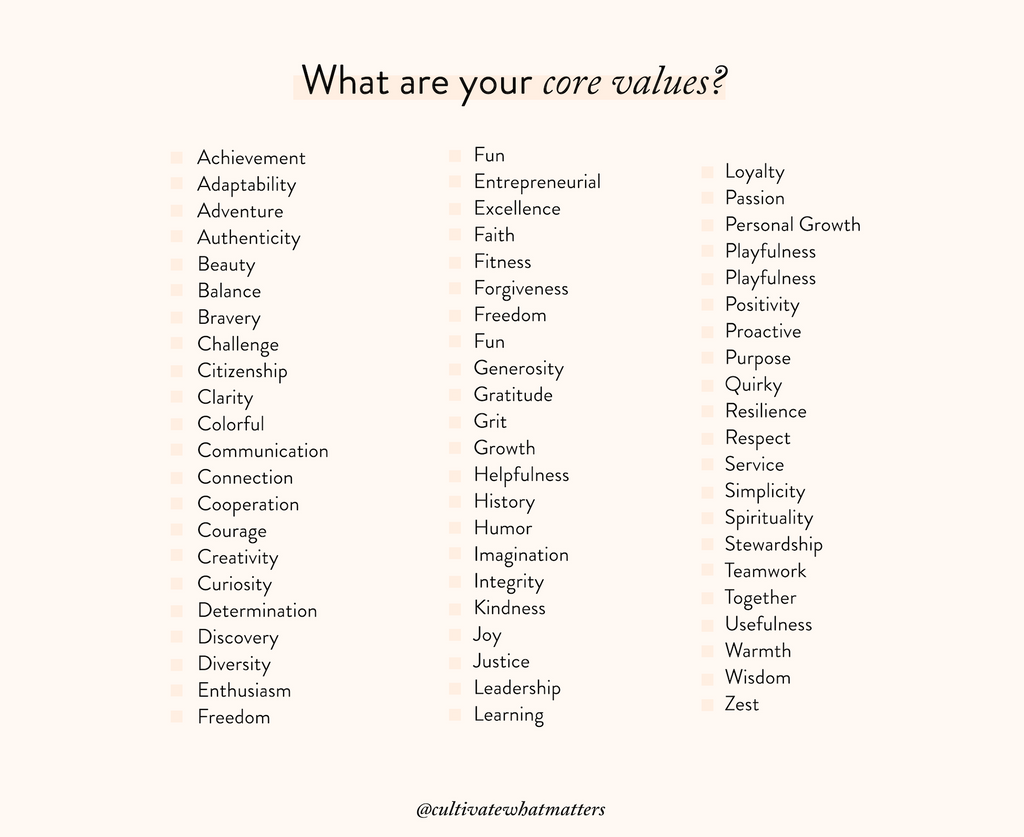Though the PowerSheets® goal planner doesn't ask you to name core values, it's an idea that deeply resonates with this community: at its heart, naming core values is a practice of naming what matters (and we love naming what matters!). Just as for individuals, naming core values for a family can be a powerful exercise in shaping your family culture, too.
Today, we're offering a few practical steps to help you name core values for your family. You'll find a few suggestions for how to put them into practice below, too!

WHY SHOULD WE HAVE FAMILY CORE VALUES?
Core values began in the corporate sphere, not the personal one. One of the first people to bring this business practice to family life was Stephen Covey, the famed organizational expert. In 1997, he adapted his best-seller The 7 Habits of Highly Effective People to the family with—you guessed it!—The 7 Habits of Highly Effective Families. In it, he suggested families create a family mission statement and core values. "The goal," he wrote, "is to create a clear, compelling vision of what you and your family are all about." No family will be perfect, but by identifying a shared destination, they're more likely to travel there together and arrive whole and happy.
Core values might sound aspirational (and in some ways, they are!), but once you and your family have named them, they provide a very practical framework by which to make decisions. When faced with a thorny issue, a crossroads, a tough decision, or a disciplinary moment, you and your partner can ask: does it fit our core values? What do our core values have to say about this? A strong set of core values should help you to say no to what doesn't fit, give an enthusiastic yes to what does, and lay the rest aside with confidence.
As parents, the practice of naming and living by core values is a powerful way to show our kids what it can look like to live with intention and thoughtfulness. So many individuals and families never pause to ask deep, meaningful questions about each other and life; this is a great way to introduce your kids to the practice of doing so.
It's often said that companies fail because they don't communicate their values—they might have them, but they don't communicate them. The same could be said of families. If we never communicate to our kids what we value and what matters, how can we hope they'll find these things to be true for their own lives?
CHOOSING YOUR FAMILY'S CORE VALUES
You're convinced core values are a good idea and ready to name some. Know that this is a process that might take vulnerability, trust, and honest conversation, but that it's worth it! Here are some tips.
1. Decide who will take part. Depending on the age of your children, you might choose to name core values with your partner and then share them with your kids, or you might walk through the process of naming them together. If possible, it's great to include your kids—they'll be more likely to buy into something they had a hand in crafting.
2. Make it a special occasion. Whether you're going it alone or involving the whole family, create a memory around the drafting. Let your kids know in advance what you're going to be doing. Get them hyped! When the time comes, set the scene with a special snack, a cozy seating arrangement, or some background music.
3. Generate ideas. Ask a few reflection questions to get everyone thinking, then allow each member of the family time to write down some thoughts. You might find it helpful the present the list of possible core values we've brainstormed below, and/or to ask a series of questions. Choose which ones resonate most with you, knowing your family best!
- What's most important to our family?
- What fires us up?
- What do we want to be known for?
- What do we want to model for others to look to?
- How do we like to spend our time?
- What words best describe our family?
- What are our strengths as a family?
- If just parents, what do we want to instill in our children?

4. Combine and simplify. Give each family member a chance to share what he or she came up with. Write all of the suggestions on a big whiteboard or sheet of paper, if you have it. A lively discussion might ensue from there as you narrow down the options to 3-8 final core values!
Though it's tempting to feel you need a laundry list of values to sum up your family, we'd highly recommend choosing no more than ten. You want each member of your family to know your core values like the back of their hand, and the more you have, the harder that is to do.
Stuck? "Identify what your values are, not what you think they should be" is the advice from Jim Collins, another famed organizational effort. "A core value," he's said, "is something so central you would say, 'Even if it's harmful to us, we would still hold on to this value.'"
What clears that bar for your family? Once you've decided, you should be left with a clear, articulate vision of what you want your family to be and the values you want your children (and yourself!) to uphold.
WHAT TO DO NEXT
Hooray—you've chosen your family core values! Far from a set-it-and-forget-it exercise, your core values should become deeply ingrained in your family's daily life. Here are some suggestions for ways to make that happen.
1. Post them in a prominent place. Though some families like to create a piece of artwork with their final core values (and this is a beautiful idea—check on Etsy for artists who may be able to help!), don't let the perfect be the enemy of the good. Post a handwritten or typed-up list of the core values somewhere everyone can see it each day (think: on the refrigerator, by the front door, in each bedroom). Repetition helps with memorization.
2. Encourage everyone in the family to memorize the core values. Make it fun! Recite them together on the way to school. Make up a song to help with memorization. Do a popcorn quiz at the dinner table with small prizes for correct answers. Offer a small reward whenever a family member has memorized all of the core values.
The sooner you all know the core values, the sooner you can start living them out.
3. Learn, reward, and correct based on your core values. Here's where it gets good. Once everyone has agreed on what matters to your family, you can bring your core values into daily interactions:
- To Reward: Having shared core values gives you more opportunities to notice the good in each other. Did you catch your children living out a core value? Call it out!
- To Correct: On the flip side, in a disciplinary moment, you have the opportunity to remind them of a core value that might be in conflict. You can ask whether they're living it out, or how they might better live it out. Living up to core values might mean sacrificing what's convenient in the moment, but you can remind each other of their worth in the big picture.
- To Learn: Just because a core value has been named doesn't mean you'll all live it out perfectly right away. Use your core values as inspiration to learn together so that you can all live them out in a deeper way over time.
- To Adjust Your Schedule: Does the way you spend your time as a family align with your core values? Having named them, could you look at your schedule and adjust how you're individually spending your time, or how you're spending the time you have as a family? Core values can inform every part of your life, but how you're spending your time is a great place to start.
We'd love to hear: do you, or does your family, have core values? Are you inspired to name some, if not?
P.S. Looking to spend more intentional time together as a family? You might love the Family Conversation Card Deck! Filled with 100 family-friendly conversation starters, it will be the star of your next meal, waiting room, or road trip.



